There are several ways to build a rope ladder. Typically your choice will be determined by what materials you have and what you are going to be using your rope ladder for. Or probably who is going to be using it, as it needs to be safe.
Before we begin, you should refresh yourself with our project on Ladder Safety and working from heights. Think about this when siting your rope ladder too, especially if children might be using it.
Types of Rope Ladder you Can Make Yourself
Broadly there are 3 types of rope ladder that you can make yourself:
- All Rope Rope Ladder
- Tied Rope Ladder
- Drilled Step or Rung Rope Ladder
We will show you how to make the second two types in this project, namely the Tied and Drilled Step Rope ladders.
The “All Rope” rope ladder is tricky to make and hard to use so we are not very keen on it. If you would like to try making one of these you can find out more on the fantastic Indestructibles Website and their rope ladder project.
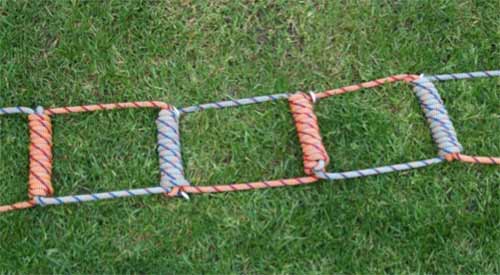
All Rope’ Rope Ladder by Indestructibles – Image courtesy of Indestructible outside
We will describe the other two types and how to build them yourself. The ‘Tied’ rope ladder is generally, and most easily, built with round rungs made from something like a broom handle and these are simply tied into the rope “strings” of the ladder.
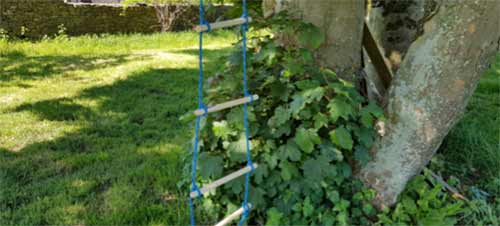
A tied rope ladder
The “Drilled Step” rope ladder is one that the rungs are flat planks through which the rope string passes. A knot is tied under each side of the rungs in the rope so that the rungs stay in place when weight it put on it.
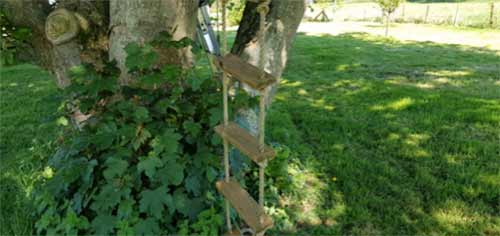
The Advantages and Disadvantages of the Types of Rope Ladder
The benefit of “Tied” type of rope ladder is that it is very easy to make and can be light, making it ideal for kids especially where the heights involved are not too high.
The disadvantage is that the knots can come loose and the rungs slide out so it does need to be checked before use and regularly. They tend to be lighter so potentially less robust if you are using them for heavier weights.
The “Drilled Step” type of rope ladder is more robust and slightly more involved to make, although only slightly. Depending on the materials you have available to make them, they can be very strong and sturdy indeed.
The tradeoff here is that this type will be much heavier, meaning it is harder to handle and needs to be tied down to ensure the rungs don’t hit anyone or anything.
Top Tip: Whichever type of rope ladder you use we recommend that you fix the bottom of the ladder to the ground as when it is climbed there is a natural tendency for your weight to swing out from underneath you making it very hard to climb.
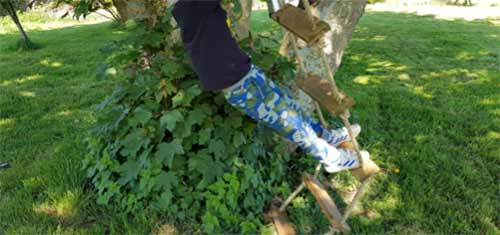
What happens if the bottom of a rope ladder is not tied down
Once you have decided which type of rope ladder that you are going to make you can get on with actually making it. Both types we describe are very simple to make and will take only an hour or so depending on how many rungs you plan to have.
How to Make a Tied Rope Ladder Yourself
To make this type of rope ladder you will need:
- Rungs – we have used broom handles, but anything round and strong will do. We have seen more rustic rope ladders made with branches
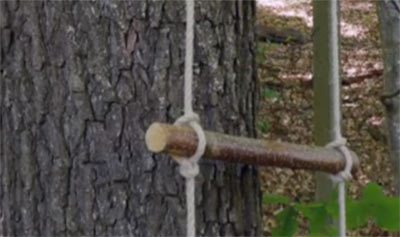
Branches used as rungs for a tied rope ladder – Image courtesy of Mark the Braider
- Rope – You will need a good quality, hard wearing rope especially if the ladder is going to be left outside. (See Below our tips for the best types of rope for the different types of ladders.)
That’s it for materials but in terms of the tools, you will need:
- Saw to cut your rungs to length
- Pencil and tape to measure the rungs
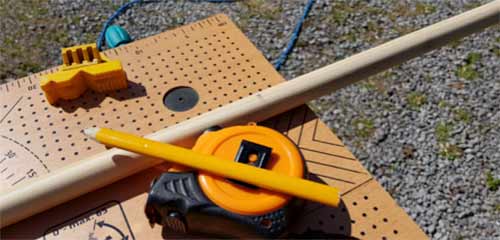
Mark your rungs before cutting to size
Step by Step Method for Making a Rope Ladder Tied with a Marlin Spike Hitch
The best, and easiest knot for tying the rungs on to your rope ladder is the “Marlin Spike Hitch”. It is a great knot for tying into a length or rope that needs to take weight in one direction (ie a ladder which take the weight vertically). It is also commonly used to tie a “T” handle into a rope used to make pulling it easier.
We will explain how to tie a marlin spike hitch with pictures below; it is much easier than it sounds, you’ll be pleased to hear.
Now you are ready to get started:
- Cut your rungs to length. Ideally they should be the same length. We used 120cm broom handles which cut down into 40cm (16 inches) lengths which are a perfect size
- If you are not using two separate pieces of rope, find the center of your rope. This will be the top of the ladder and can be looped over whatever you are climbing (assuming it is secure). Each end of the first rung will be tied at an equal distance from this point
- Then you need to tie all the rungs to the rope. It is worth spacing out the rungs along the rope so that they are in roughly the right place. This will save too much fiddling about to even out the rungs and get them level
- Tie each end of each rung using a Marlin Spike Hitch
- Make a loop in the rope just below where the rung should be. Sailors call a ‘loop’ a bite, so you might hear that term used
- Fold this loop up the towards the top of the ladder so the center of the loop sits on the rope above where is was first made
- Pull the rope through the center of the loop. Pull enough of the rope through so that the end of the rung can be fed through
- Push the rung through so that it will be held by the knot
- Tighten the knot, once it is in the right position
- Repeat the process for the other side of the rung. There might be a little tweaking and adjusting of the knots to ensure that the rung is level, and where there are more than one, that they are an equal distance apart
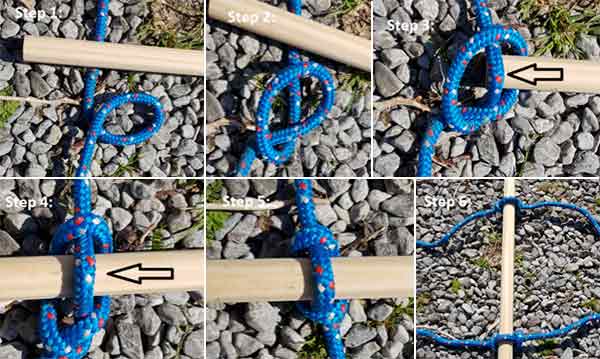
Steps for tying rungs onto a rope ladder
- Tie on all the rungs that you need for the height that the ladder needs to be. When you are more practiced you will be able to do this in situ, which does make spacing the rungs easier
- Hang your ladder in place and make any final tweaks to the rung spacing and to ensure that the rungs are level. (We will cover how the fix the ladder in place below, as this is relevant to both types of ladder)
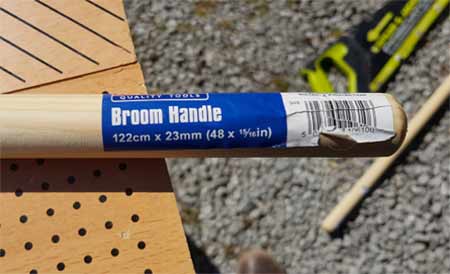
Broom handle used to make rope ladder rungs
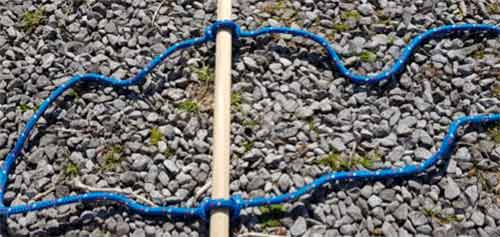
Tie each rope ladder rung in place both sides
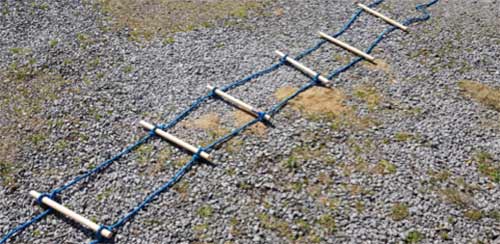
Rope ladder tied and completed
From start to finish, including the time-consuming tweaking to get all the rungs level and evenly spaced to make this kind of rope ladder takes about 40 minutes for a 6 rung ladder.
A handy tip passed on to us by one of our readers concerning marlin spike knots is:
for a more permanent fixing you can use a constrictor knot instead of a marlin spike hitch. They can be impossible to undo and also won’t work loose when not under load.
How to Make a Drilled Step or Rung Rope Ladder Yourself
To make this type of rope ladder you will need:
- Planks – cut to length to make the rungs. In our example we have used some left over decking planks, which are about as big and thick as we would recommend; thinner lighter planks would have been preferred if we had them. However, if the ladder is to be used outside, then make sure they have been treated
- Rope – a good quality synthetic rope is best, especially if you are going to leave the ladder outside. See below for our suggestions about the type of rope you should use
Again, this is all you will need for materials. In terms of tools you will need:
- Saw – to cut the plank into your rungs
- Pencil & tape – to measure and mark lengths of rungs, and to mark where the holes for the rope will be.
- Drill and bit (sized to the thickness of the rope)
- Sander (optional) to round off the edges of the rungs once cut
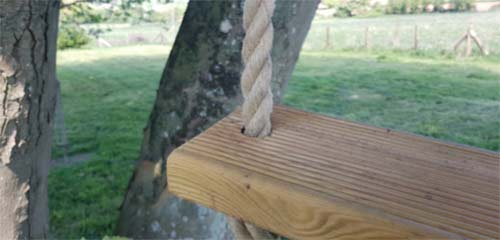
Once cut, the edges of the rungs are rounded
Step by Step Method for Making a Sturdy Drilled Step Rope Ladder
The process is very simple, and the outcome is an incredibly study rope ladder. As we have mentioned already, we have used some left over decking planks for the rungs. This is about as big and heavy as you should use as it makes the whole ladder heavy and cumbersome. However any spare, treated planks are generally ideal.
Now here’s how you go about it:
- Cut your planks into rungs. 40-50cm (approx. 15-20 inches) is a typical size but there are no set rules. Anything that works for you given the thickness and width of the plank you’ve chosen. If you want to round off the edges, you should do so now
- Mark up and drill the holes for the rope to pass through. Drill a hole that it a few mm larger than the diameter of your chosen rope. This will mean that it can pass through it easily
- String the rungs on to each rope. And then space them out so that they are roughly in the positions you want them. Don’t worry too much as you can tweak and adjust them later
- Tie a simple knot in between each rung under the position you want your rung to be. Then slide the plank down on to the knot to form the rung
- Adjust the knots so that the rungs are evenly spaced and level
- Hang your ladder (see below for tips about how to do this)
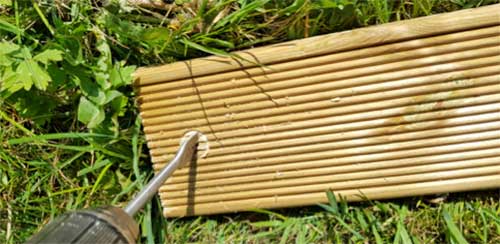
Drilling holes for rope in rope ladder step

Start to finish this type of rope ladder takes a little longer time than the tied rope ladder, partly because we were using larger timbers, but also because of the additional step to drill the rungs. This ladder with 6 rungs takes around 1 hour to build, or possibly under if you have a good chop saw read to use.
How to Hang or Fix your Rope Ladder in Place
There are no rules for fixing your rope ladder in place, as such, but you do need to ensure that it is fixed securely and will not fall down. You do not want the ladder to come unattached and fall on top of you when you are at the bottom, or worst, to come unattached when you are at the top so you fall all the way back down.
For the first type of ladder we described, the Tied Rope Ladder, we used a single piece of rope to make it, so there was a loop created at the top of the ladder.
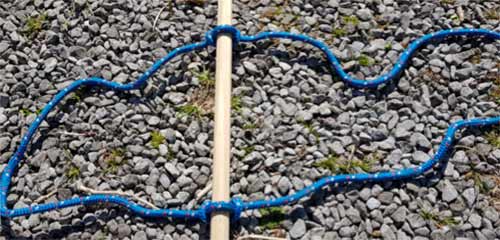
Loop at the top of a ladder which can be hung over your fixing point
The loop that is created can be used to hang over a fixing point, such as a sturdy branch, so as to provide a strong anchor for the ladder.
For the other type of ladder that we described, we use two separate pieces of rope. We ordered the rope to come with eyes spliced into the ends. This allows us to easily hook them over an anchor point. In this case it is an old scaffold bar which has been securely fixed to the entrance to a tree house.
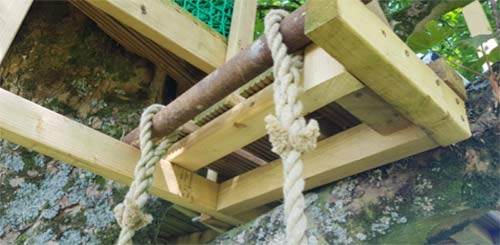
Eyes spliced into the rope make it easier to fix the top of your rope ladder
It is important to fix the bottom of the rope ladder to the ground so that the ladder is taut and ideally is slightly off vertical. This will make it much easier to climb. If you do not your weight swings under you so it is hard to climb up the ladder using your legs.
Make sure that the stakes or pegs securing the base of the ladder as flush with the ground and covered with something soft so they cannot do any damage if fell upon.
When it comes to climbing your rope ladder a further handy tip has been passed on by one of our users:
To climb a rope ladder with much less “swing” place one foot into the ladder toe first, as normal, then place the second foot in heel first, from the other side. This method has the other advantage that you can lift your weight with your legs rather than your arms so is much less tiring on a long climb (not really relevant accessing a tree house, but valuable when caving)
.
The Best Types of Rope for Making a Rope Ladder
The type of rope you use will depend on the type of rope ladder you are making. The Tied Rope Ladder will typically use a thinner rope as this will be easier to tie the knot (Marlin Spike Hitch). Also it will look odd if the thickness of the rope is bigger or approaching the diameter of the rungs.
We used an 8mm braded polyester rope which will be plenty strong enough and also last well, even outside.
For the Drilled Rung Rope Ladder we used a thicker rope 24mm, as we were using larger rungs to make the steps and a thin rope would look out of place. We also used a 3 strand rope, which is the traditional form for rope so (we think) a little more appealing.
As the knots under each rung of the drilled ladder were very simple there was no need for a braided rope. However it is generally easier to knot a braided rope so you might find it preferable to use one for the tied ladder.
We would recommend using a synthetic rope, even if using a hemp style rope. This will last longer especially if the ladder is to be left outside.
When buying rope many merchants, even online, will offer you the opportunity to have an eye spliced into the end or the ends whipped (tied off neatly so that they don’t fray). This is completely up to you whether you would like to take advantage of this service and sometimes it is helpful.
Be aware that you will probably have no say how big the eyes will be. We had intended to slide the eyes over a piece of 3”x2” but the eyes were not big enough, so we had to use an old scaffold bar instead. Also the whipping might not be necessary as you can “burn” off the ends of the rope as they will melt being synthetic, so you might not need to pay extra for this service.
In summary, making a rope ladder is a great little project that should take no more than an hour or so, assuming you have the materials to hand. There are a number of types of rope ladder depending on the situation and who’s going to use it.

